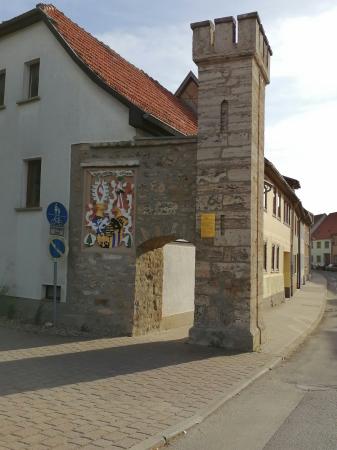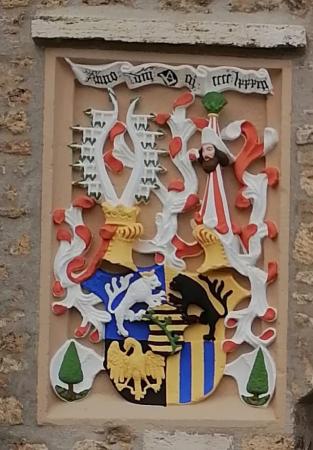Brückentor
-
1482 bis 1483 erbaut
-
1483 hochgotischer Torwappenstein aus Sandstein
-
1850 Abriss des Brückentores und Ersatz durch neogotische Torpfeiler um
-
3. Haupttor der Stadt
Das ehemalige Brückentor ist das letzte der 5 Stadttore und eines der 3 Haupttore der Stadt. Durch das Tor führte die Salzstraße, eine von 2 wichtigen mittelalterlichen Handelsstraßen, die sich in Tennstedt kreuzten.
Nach einem Kupferstich von Merian war das Brückentor ursprünglich ein viereckiger Torturm mit spitzer Haube und Plattform mit Zinnenkranz und Turmbekrönung. Mit der Fertigstellung des Tores im Jahr 1483 wurde der älteste Torwappenstein Tennstedts eingesetzt. Auf diesem ist neben dem sächsischen Herrschaftswappen auch die älteste Darstellung des Tennstedter Wappens erkennbar. Vermutlich war der Wappenstein mittig über dem Tor angebracht. Diese Anordnung fand sich im Langensalzaer Tor und ist heute noch im Osthöfer Tor erhalten.
Am 3. März 1636 fielen die Schweden während des 30jährigen Krieges erstmals plündernd und brandschatzend in Tennstedt ein. Innerhalb von 4 Stunden wurde die halbe Stadt niedergebrannt. Auch das Brückentor fiel diesem Ansturm zum Opfer. Nach der Plünderung der Stadt wurde auf Anweisung des Rates der Stadt das Tor vermauert. Am 12. April 1640 kamen die Schweden von Norden her und schlugen das Tor ein. Tennstedt wurde erneut geplündert, worauf das Tor im Jahr 1641 wieder zugemauert wurde. Zahlreiche Beschwerden der ansässigen Bauern, die nun keinen direkten Zugang zu ihren Feldern hatten, führten zur Wiederöffnung des Tores. Nachdem die Winterbestellung der Äcker abgeschlossen war, wurde das Tor wieder vermauert. Am 24. Mai des darauffolgenden Jahres wurde auf Anweisung des Rates das Tor dauerhaft geöffnet.
1643 wurde zu beiden Seiten des Toreinganges aus Richtung Norden eine mannshohe Mauer angebracht, die mit einem Gatter verschließbar war. Welche Funktion dieser Bau hatte, erschließt sich nicht, da die Mauer für eine Verteidigung der Stadt zu niedrig war. Um 1850 wurde das Brückentor wegen des Neubaus der Brückenstraße abgerissen. An Stelle des Tores wurden ähnlich dem Langensalzaer Tor zwei neogotische Torpfeiler mit Zinnenkranz errichtet. Ebenso wurden die mannshohen Mauern zum Schutz der Fußgänger durch niedrigere ersetzt. Das Torwappen erhielt einen neuen Platz und wurde im Bereich des linken Pfeilers neben der Durchgangspforte eingesetzt. Beim Neubau der Brücke über den Klunkerbach in den 70er Jahren des letzten Jahrhunderts wurden der rechte Pfeiler und die Mauern entfernt.
Der linke Pfeiler mit Durchgang und Wappenstein ist bis heute erhalten geblieben. An der Stadtseite des Turmes befindet sich ein sogenanntes "Schwarzes Brett". Bis weit in die 1980er Jahre wurden am Schwarzen Brett Mitteilungen angebracht, in denen die Stadtverwaltung die Bevölkerung über wichtige Angelegenheiten informierte.
Bridge Gate
-
1482 to 1483 built
-
1483 highly Gothic gate stone made of sandstone
-
1850 demolition of the bridge gate and replacement with neo gothic gate pillars
-
third main gate of the city
The former Bridge Gate is the last of the five city gates and one of the city's three main gates. The "Salt road" let through the gate,one of 2 important medieval trade routes that crossed in Tennstedt. After a coppperplate engraving by Merian, the Bridge Gate was originally a quadrangular gate tower with a pointed hood and platform with a crenellated crown and tower coronation. With the completion of the gate in 1483 Tennstedt`s oldest stony heralcic figure was used. In addition to the Saxon coat of arms , the oldest depicition of the Tennstedt coat of arms can be seen on this. Presumably, the crest stone was placed in the middle of the gate. This arrangement was found in the Langensalzaer Tor (Langensalzaer Gate) and is still preserved in the Osthöfer Tor (Osthöfer Gate) . On March 3, 1636, the Swedes fell during the 30 Years War (1618 - 1648) for the first time plundering and fire-prone in Tennstedt. Within four hours half of the city was burnt down. Also, the Bridge Gate fell victim to this onslaught. After the plundering of the city, the gate was walled up at the direction of the council. On April 12, 1640, the Swedes came from the north again and beat the gate. Tennstedt was plundered again, after which the gat was bricked up in 1641 again- Numerous complaints from the local farmers, who now had no cirect access to their fields, led to the reopening of the gate. Afterthe winter tilling of the fields was completed, the gate was walled up again. On May 24 of the following year, the gate was opened permanently at the direction oft the council. In 1643, a man-high wall ws erected on both sides of the gate from the north, which was closed with a gate. It ist not clear what function this wall had, because the wall was too low for a defence of the city. Around 1850, the Bridge Gate was demolished because of the reconstruction of the Brückenstraße (Bridge Road). In place of the gate two Neogothic crenellated gate pillars were built similar to the Langensalzaer Gate. Similarly, the man-high walls were replaced by lower ones to protect the pedestrians. The gate emblem was given a new place and was used in the arewea of the left pillar next passage gate. In the construction of de bridge over the Klunkerbach (a brook) in the 70s of the last century, the right pillar and the walls were removed. The left pillar with passage and crest stone has been preserved to this day. On the city side of the tower is a so-called "bulletin board". Until well into the 1980s, important bulletins were posted on the bulletin board, informing the public abaout inmprtant matters.







